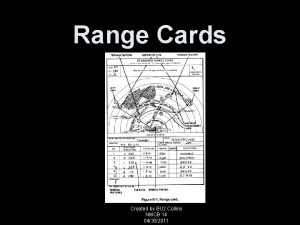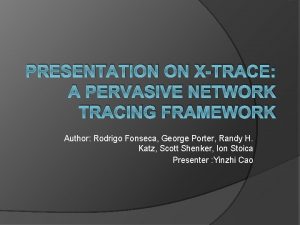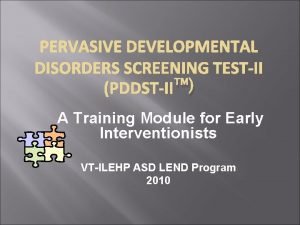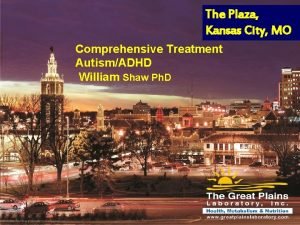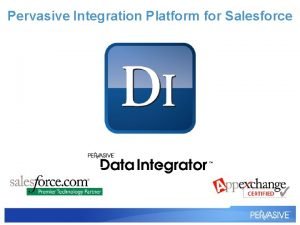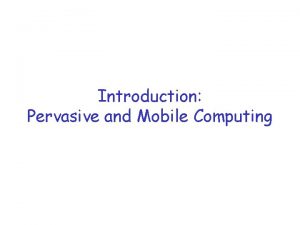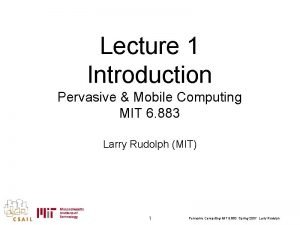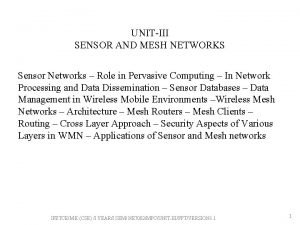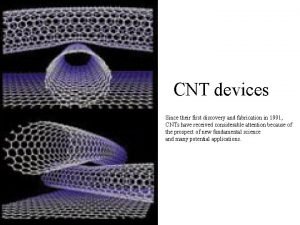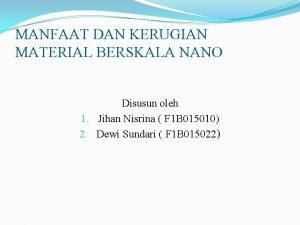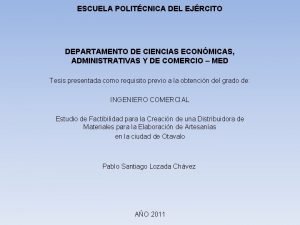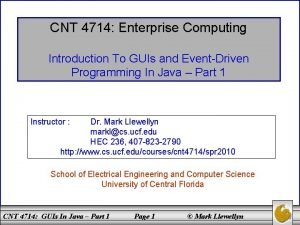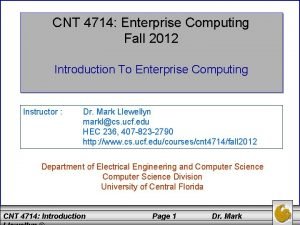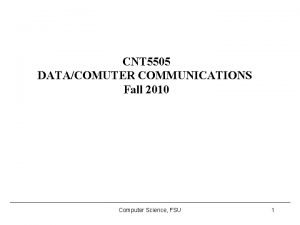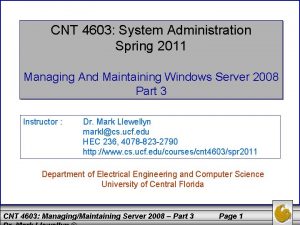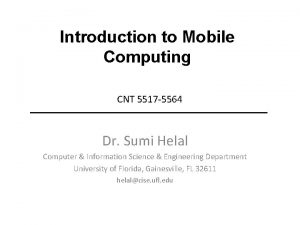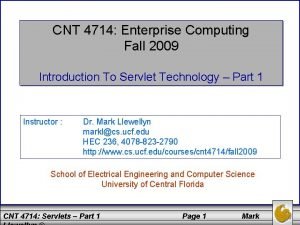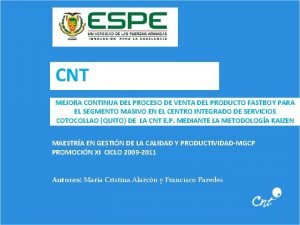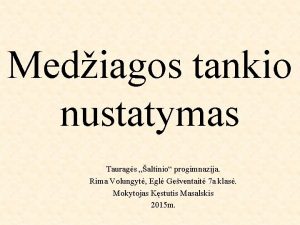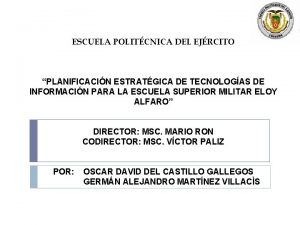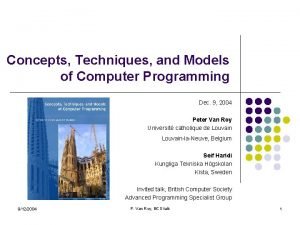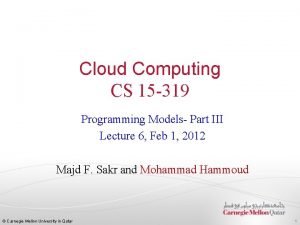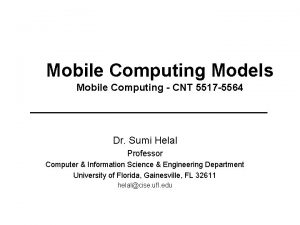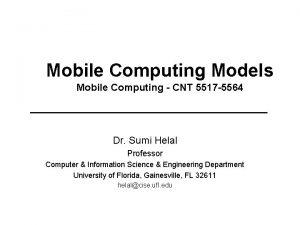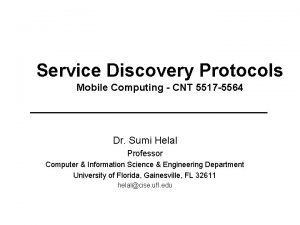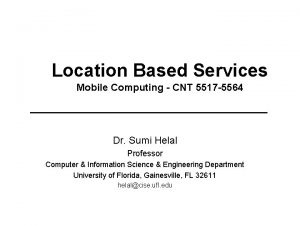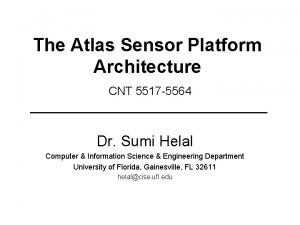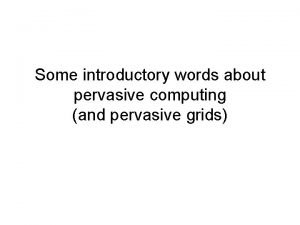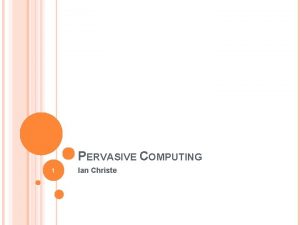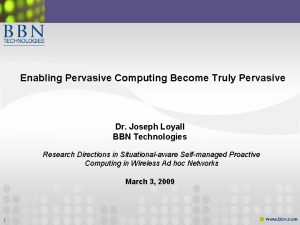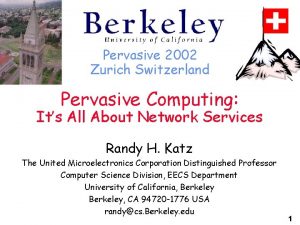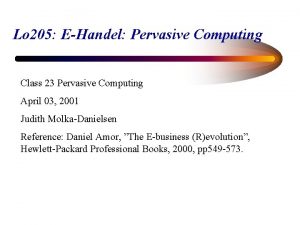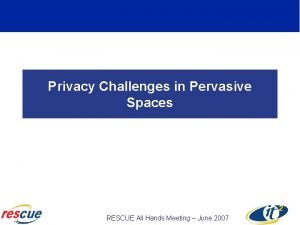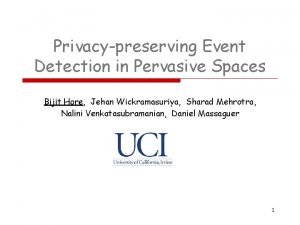Programming Models in Pervasive Spaces CNT 5517 5564

















![Measuring Data Quality [5] • Data Quality Indicator (DQI) associated with reading from each Measuring Data Quality [5] • Data Quality Indicator (DQI) associated with reading from each](https://slidetodoc.com/presentation_image/09a079faa382d20561f3e4cf82854f43/image-18.jpg)
















- Slides: 34

Programming Models in Pervasive Spaces CNT 5517 -5564 Dr. Sumi Helal Computer & Information Science & Engineering Department University of Florida, Gainesville, FL 32611 helal@cise. ufl. edu

Reading Materials 1. H. Yang and A. Helal, "Safety Enhancing Mechanisms for Pervasive Computing Systems in Intelligent Environment", In Proceedings of the Middleware Support for Pervasive Computing Workshop, held in conjunction with IEEE Per. Com 2008, Hong Kong, March 2008. (pdf) 2. H. Yang, E. Jansen and A. Helal, "A Comparison of Two Programming Models for Pervasive Computing, " Proceedings of the Workshop on Ubiquitous Networking and Enablers to Context Aware Services. In conjunction with the IEEE/IPSJ International Symposium on Applications and the Internet (SAINT), Phoenix, Arizona, January 2006. (pdf) 3. C. Chen and A. Helal, "Device Integration in SODA using the Device Description Language, " Proceedings of the IEEE/IPSJ Symposium on Applications and the Internet, July 2009, Seattle, Washington, USA. 4. Scott de Deugd, Randy Carroll, Kevin E. Kelly, Bill Millett, and Jeffrey Ricker, "SODA: Service-Oriented Device Architecture, " IEEE Pervasive Computing, vol. 5, no. 3, 2006, pp. 94 -C 3. (pdf) 5. R. Bose, A. Helal, V. Sivakumar and S. Lim, "Virtual Sensors for Service Oriented Intelligent Environments, " Proceedings of the Third IASTED International Conference on Advances in Computer Science and Technology, Phuket, Thailand, April 2 -4, 2007. (pdf)

The Need for Programming Models • Development with ad-hoc strategy in integrated environment is not scalable • Programmability is essential if a full life-cycle of the pervasive space is to be supported • Cost of deployment is high without proper programming model, preventing mass real-world deployments • Proper programming model can incorporate and enforce critical features such as security, privacy and safety

What is Programmable? • • User Safety User Desires and Expectations User Concerns and Frustrations User Privacy Space (Environment) Safety Space Rules Human Computer Interface Availability of Service (Ao. S)

Emerging Models • • Service Oriented Models Reactive Models Context Driven Models Safety Oriented Models

Safety Perspective Safety Mortar & Brick Context Driven Models Safety Oriented Models Service Oriented Models Minimal Accepted Safety Expressiveness

Service Oriented Model • Each sensor, actuator or device in the space is represented by a service – How? (See [3][4]) - Role of standards • Software services • Service composition into applications, also represented as services • Main Gain: – Automatic Integration – Openness – Programmability using well-established model & tools

Automatic Integration (Plug & Play into the Pervasive Space) • A joining entity should be able to explore the pervasive space to self-integrate itself as a service and to possibly enable the activation of other composite services • A joining entity should be able to contribute meaningful knowledge to the pervasive space to enable powerful programming models. • A leaving or failed entity is automatically and cleanly removed from the pervasive space.

Openness (Nov 22, 2007, Silicon Valley, CA: XYZ, Inc. “opens doors” with its Smart. Knob product for smart homes) • The pervasive space is open and flexible to embrace a variety of entities without any special favor towards particular participants or their underlying technology. • Openness via the use of well-established existing standards. • Additional “needed” standards are proposed.

Programmability (Visual Studio/eclipse for Pervasive Spaces ) • Pervasive Space aware of its sensors, actuators, contexts & applications (goals) • Pervasive space able to map itself automatically into a project in an IDE. • Program the pervasive space via “logical wiring” within the IDE. • Notice IDE is used here as both a development tool and a run-time control and information environment. • Different IDE’s for different programmers: – Computer scientist programmers – Domain expert programmers.

SOA Model: Critical Consequence Ease of Integration via SOA Fault-Tolerance due to SOA

Virtual Sensors Sustaining SOA Model in Pervasive Spaces Service Knowledge Collection of Sensors

Virtual Sensors Classification Derived Virtual Sensor Basic Virtual Sensor Singleton Virtual Sensor Knowledge Type of Phenomena Measurement Unit Location. . Single Physical Sensor Singleton Virtual Sensor Physical Sensor

Virtual Sensors Classification Derived Virtual Sensor Basic Virtual Sensor Knowledge Type of Phenomena Aggregation Formula DQI. . Collection of Singleton Virtual Sensors Singleton Virtual Sensor Physical Sensor

Virtual Sensors Classification Derived Virtual Sensor Basic Virtual Sensor Singleton Virtual Sensor Physical Sensor Derived Virtual Sensor Knowledge Type of Phenomena Aggregation Rules Location. . Collection of Basic and other Derived Virtual Sensors

Virtual Service Composition User Application select ‘weather’ from location = ‘area 51’ Framework Controller Knowledge Weather Sensor (Derived VS) Temperature Sensor (Basic VS) area 51 area 50 Base Humidity Sensor (Basic VS) area 48 area 49

Extending Availability • Collect similarity statistics to determine groups of sensors exhibiting similar behavior over time • When a sensor fails, approximate its readings using other live sensors • Decision regarding which live sensor to choose is made using similarity statistics such as Euclidean distance
![Measuring Data Quality 5 Data Quality Indicator DQI associated with reading from each Measuring Data Quality [5] • Data Quality Indicator (DQI) associated with reading from each](https://slidetodoc.com/presentation_image/09a079faa382d20561f3e4cf82854f43/image-18.jpg)
Measuring Data Quality [5] • Data Quality Indicator (DQI) associated with reading from each virtual sensor service • Gives a quantitative measure of sensor data quality • Takes into account whether sensor readings are originating from live and intended sensors, or are being approximated • DQI = 100 * (NC + Σg(ts – Tstart)Ws) / N s є S F

Comparison of Data Quality Gain in Reliability Data Quality Threshold Gain in Availability

Context-Driven Programming Model • A formal framework for contexts and action semantics, based on domain ontology. • Capable of evaluating potential actions based on currently active context • Capable of defining and detecting conflicting actions • Capable of defining and preventing dangerous contexts

Context-Driven Programming Model (cont’d) • Simple programming procedure to program the pervasive space – Defines – Mappings of Contexts to Actions – Reporting • Less expressive than the SOA model – Limits by the procedure, which follows the model (no time capture), simple logic.

Programming Procedure • Design the Context Graph: – • Decide what the domains of interest are, and what the contexts of interest within these domains are. Interpret Sensor Readings: – • Define interpretation functions from ranges or enumerated possible reading values from various sensors to atomic contexts appearing in the context graph. Describe Intended Behaviors: – Describe intended behaviors in terms of action statements associated with each context in the context graph, so that smart space knows which actuators to manipulate when various contexts become active.

How does it work? • Build the context graph that captures all possible states of interest in the smart space. • Contexts are marked as desirable, transitional, or impermissible. • Programmers define the intentional effects of actuators in terms of transitions from one context to another. • The system identifies active contexts from sensor readings and choosing actions toward more desirable contexts.

IDE (Context Model) Entity View

IDE (Context Model) Behavior View

Safety-Oriented Programming Model • High expressive with explicit safety guarantees / enforcements • Expressiveness: relies on SOA (e. g. Atlas) • Safety: No absolute safety guarantees – Large safety net open for expansion – Enforcement and guarantees throughout the entire pervasive space life cycle.

Comparing Programming Safety Computer System vs. Pervasive Space Y = X/0 Memory access violation Divide by 0 Interrupt Fire Alarm Out of Impermissible Range Context Exception

Four Critical Elements 1. Devices: Sensor & Actuator 2. Services & Applications 3. User 4. Space

The Auto scooter Concept • The all-around rubber bumper • The flat-out speed • The over-turning wheels • Corrective driving

Device Safety • Ensure inclusion of device exception handling routine • Avoid conflicting directives and unsafe/unacceptable operations (utilizing context) • Regulate the incoming commands and detect abnormal command, access pattern (frequency) and out of range setting (operational compliance)

Service Safety • Define impermissible contexts • Map impermissible contexts to services (M -M) • On detecting impermissible contexts, deactivate corresponding services.

User Safety • Express user safety concerns in form of user profile • Device mechanisms that map and enact safety concerns (knowledge) into compiletime and run-time safeguards

Space Safety • Similar to user safety, express space safety concerns as a user profile • Allow for space safety to integrate with user safety (personalizing the space safety concerns) • Map and enact space safety into compiletime and run-time safeguards

Piecing Space element Safety Space Spa Saf ety User S rv ic e Sa f et y “SAFE” SPACE afety Se De vic e S afe ty ce
 How to fill out a range card
How to fill out a range card Mobile and pervasive computing
Mobile and pervasive computing X-trace: a pervasive network tracing framework
X-trace: a pervasive network tracing framework Pddst
Pddst Pdd disorder
Pdd disorder Salesforce company overview
Salesforce company overview Pervasive and mobile computing
Pervasive and mobile computing Pervasive and mobile computing
Pervasive and mobile computing Primary and secondary stakeholders
Primary and secondary stakeholders Pervasive computing ppt
Pervasive computing ppt Pervasive mood
Pervasive mood Mobile computer wikipedia
Mobile computer wikipedia Cnt discovery
Cnt discovery Adapun cnt adalah
Adapun cnt adalah Organigrama cnt
Organigrama cnt Cnt 4714
Cnt 4714 Cnt 4714
Cnt 4714 Cnt 4603 fsu
Cnt 4603 fsu Cnt 3004
Cnt 3004 Cnt 4603
Cnt 4603 Cnt phones
Cnt phones Int cnt
Int cnt Cnt 4714
Cnt 4714 Estructura organizacional de cnt
Estructura organizacional de cnt Medžiagos tankis ppt
Medžiagos tankis ppt Cnt servicio al cliente
Cnt servicio al cliente What is the difference between models & semi modals
What is the difference between models & semi modals Concepts, techniques, and models of computer programming
Concepts, techniques, and models of computer programming Flair furniture company linear programming
Flair furniture company linear programming Cloud computing programming models
Cloud computing programming models Cloud computing programming models
Cloud computing programming models Integer programming vs linear programming
Integer programming vs linear programming Perbedaan linear programming dan integer programming
Perbedaan linear programming dan integer programming Definisi integer
Definisi integer Greedy algorithm vs dynamic programming
Greedy algorithm vs dynamic programming
